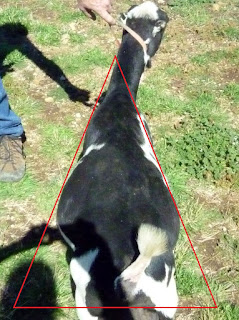The Dairy Triangles
Angularity
Angularity refers to the dairy triangles, or 'wedges', and the sharpness of line visible in dairy animals and which contrasts with the round, thick aspects of form common to meat animals.
There are several dairy triangles visible when observing animals from different points of view.
The most obvious is the triangle visible from the side, with the animal in profile. She should be long and level across the top, deep in the rear flank, with the underline deepening from the brisket (elbows) to the foreudder. This is the first dairy triangle or wedge shape. It is the basis for determining body capacity, which helps enable maximum milk production.
The second is the triangle visible when viewing the animal overhead and from the rear. The head forms the point, while the body increases in width smoothly from front to rear. The well sprung ribs and rear end form the widest part and base of the wedge. Width in the rear is necessary to provide room under the pelvis from which the udder is supported. In addition, the deep, wide, barrel, with wide spring of rib maximizes the body capacity of the animal.

The third triangle is that formed from the rear, by the framework of the hind legs. The top is the tail head, and the shape increases in width as your eye travels down towards the ground, where the legs and feet complete the sides and base. Great width is needed here as this is where the mammary is placed.
Develop an 'eye' for recognizing the three dairy triangles. They are a quick way to recognize dairy character, the will to milk, and the strength to sustain it.



No comments:
Post a Comment